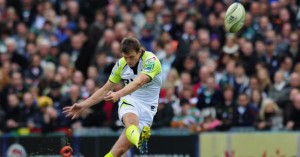
Desperate: Bradley Davies was part of a Cardiff side that were handed out a painful lesson by Leinster
by Paul Williams
A MONTH is a long time in Welsh rugby. Let’s take a look at look at the highs and lows of October:
A watershed for the Cardiff Blues?
Damian Browne, Jamie Heaslip, Fionn Carr, Cian Healy, Dave Kearney, Ian Madigan, Richardt Strauss and Jordi Murphy. You may wonder why I’m reeling off the Leinster squad that faced Cardiff Blues on Saturday night. I’m not. I’m listing the players who scored a try against Cardiff Blues on Saturday night – eight players in total. 54% of the Leinster XV crossed the line against Cardiff Blues – Heaslip scored twice. Over the 80 minutes Leinster controlled a crucial 75% of the attacking possession. It enabled Leinster’s backrow to carry the ball almost twice as far as the Blues loose forwards – 94m versus 40m.
It also allowed the Leinster backline to carry the ball and break the line at will – they carried the ball 308m compared to the Blues 220m. But by far the most damning stat of the game was Jamie Roberts’ tackle count. Roberts had to make 18 tackles at inside-centre – he completed 16 and missed two. If your inside-centre is forced to make 18 tackles, then the opposition’s No 10 has had way too much possession. In fact, Roberts made more tackles than any of the backrow players on either team.
We’re all aware of the reasons why Cardiff Blues are struggling – a new coach, the significant loss of experienced players and the constrained financial landscape of regional rugby in Wales. But it doesn’t make it any easier to watch – at the moment it’s like sitting in front of a low-budget rugby horror movie.
Heineken Cup highlights regional problems
During the opening 4-6 weeks of the season, the impact of the financial crisis in Welsh rugby was largely muted. With average Scottish teams, unpredictable Italian performances and the Irish teams protecting their squads for bigger and better things, the RaboDirect Pro 12 is a league where poor performances can easily be camouflaged.
The Heineken Cup is not. After just two rounds both the Scarlets and Cardiff Blues have just one point from two games and are essentially out of the competition. Even though the Ospreys find themselves in second place in a highly competitive Pool 2, their capitulation in the last ten minutes against Leicester was alarming – contenders for the later stages of the Heineken Cup do not concede three tries in nine minutes. Heineken used to ‘refresh the parts that other beers cannot reach’ – refreshing the Welsh regions this term may be beyond even its reach.
Warburton v Tipuric
Many people view the Warburton versus Tipuric issue as a problem. I don’t. It’s not a problem, it’s a privilege. The Welsh team haven’t had two open sides of such quality for 20 years, maybe ever. These are the selection dilemmas that New Zealanders, Australians and South Africans have historically dealt with. To be questioning which is the better of two open-sides in Wales is a milestone for Welsh rugby. Both Warburton and Tipuric’s skillsets place as them as two of the finest open sides in the northern hemisphere. There are tier one nations who can’t even summon one world class open-side. Wales have two.
Biggar the better
Dan Biggar was booed at the Ospreys kit launch in the close season by his own fans. He’s come a long way since then. His performances this season have been of Test quality and have largely silenced the calls for Matthew Morgan to replace him as the starting No 10 at the Liberty Stadium.
He’s the top point scorer and the leading goal kicker in the RaboDirect Pro 12. But it’s his performances in the Heineken Cup which have been most impressive.
Barring his frighteningly flat, miss one, pass against Leicester, Biggar has been a rare Welsh highlight in the Heineken Cup. His short, mid and long range distribution is assured from both hands. His line kicking is deep, his tackling is solid and his goal kicking would be a massive boost for Wales – his six from six display at Welford Rd was lauded by his opposite number Toby Flood, high praise indeed. If selected at No 10, with Leigh Halfpenny at full-back, it would allow Wales to have two 80% goal kickers on the field at the same time – something Rhys Priestland is currently unable to offer. But Biggar’s GK % has never been his Achilles heel. Biggar’s problem has always been his BC% – Back Chat percentage. If he can keep that figure in check, he may yet figure prominently in the Autumn Internationals.
November is vital for Wales
This column is intended to be a look at the previous month in Welsh rugby. However, such is the importance of November that it warrants a mention here. Wales simply must perform in the Autumn Internationals. It’s not just a matter of IRB ranking points – which will determine Wales’ seeding in the 2015 World Cup. If Wales don’t perform well in November then the structure of Welsh rugby may seem off kilter. Currently, the entire Welsh set-up is geared towards the national team, with serious resources spent on propelling the Test team up the rankings.
Currently it’s working; Wales are genuine contenders for a place in the IRB’s top three. But if Wales don’t win three out of four Autumn Internationals, then questions will be asked. Wales are the only test side in the IRB’s top seven teams where test success comes at the expense of its clubs/ regions. With the possible exception of Australia, this year at least, New Zealand, South Africa, France, England and Ireland all manage to maintain competitive test teams alongside strong club/ regional squads – currently Wales do not.






